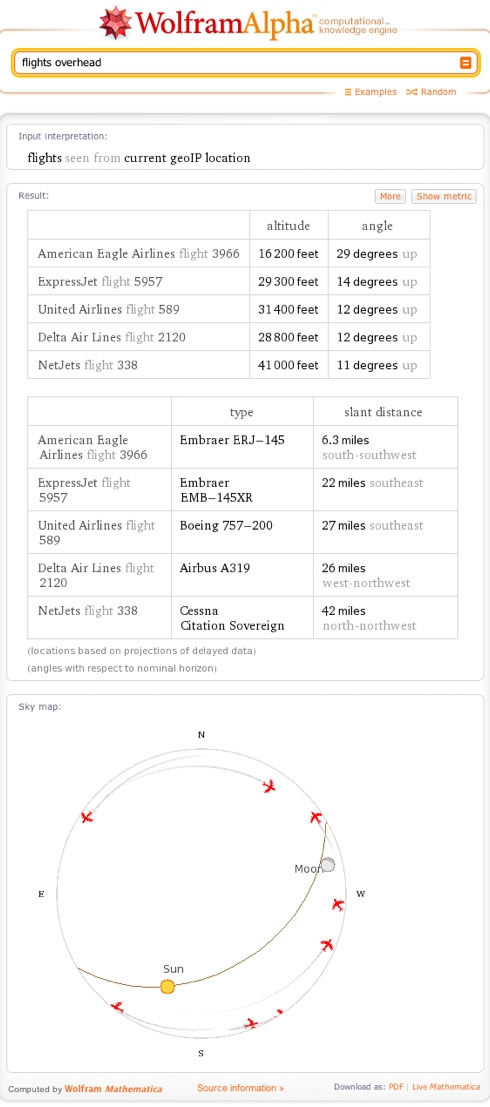
Wolfram Alpha Shows Flights Overhead
Online search service Wolfram Alpha now lets users in the United States find out what flights happen to be overhead at any given moment.
Wolfram Alpha can now help users answer questions and provides interesting queries about commercial and other flights.
By trying a simple query "flights overhead" the search engine returns information on aircraft that should be visible to user, assuming a clear sky and unobstructed view. For those who are on a location-aware msobile device, the results should be based on their precise latitude and longitude - otherwise, Wolfram Alpha will use the best available location information from their browser. Hovering over an individual plane in the sky map will produce a tooltip with the airline and flight number:

By clicking on one of those flights (or type in an airline and flight number directly) a detailed snapshot of that flight's current location, origin and destination, and other statistics about its journey will be provided. And for those who are using the service during a flight, they can see at a glance where their plane is and which cities and other airports are nearby.
If a flight doesn't have onboard internet access, users may also take a photograph through the window of a plane and when they're back on the ground, check the timestamp of the photograph and plug it in along with their flight number. Wolfram Alpha will tell them exactly where they were at that moment.
The search engine also provides information of upcoming departures with a query like "flights from San Diego International Airport to NYC".
Wolfram Alpha can also do some interesting analyses on larger sets of flights. For example, a query like "departure delays for flights from NYC to Los Angeles on October 29 will return that there were some pretty long delays that day as well as clues to the possible reason for the delay.
Note that the core data on flights comes from the Federal Aviation Administration (FAA), so at the moment, Wolfram Alpha can only answer questions about flights with at least one endpoint in the US. The FAA's flight data doesn't include airline schedules, so users can only look forward 24 hours or so to pick up filed flight plans.
Also note that because the FAA's data feed has a built-in delay, Wolfram Alpha is actually computing the current position of flights in the air, based on roughly 5-minute-old location, heading, and speed information. As a result, there may be some slight discrepancy between the actual and projected position of any given flight.
This new functionality is also featured in the recently released Wolfram Travel Assistant App, which provides a quick way to look up flight information and perform dozens of other useful travel-related computations, including currency and time conversions, weather forecasts, cost of living comparisons, and more.
By trying a simple query "flights overhead" the search engine returns information on aircraft that should be visible to user, assuming a clear sky and unobstructed view. For those who are on a location-aware msobile device, the results should be based on their precise latitude and longitude - otherwise, Wolfram Alpha will use the best available location information from their browser. Hovering over an individual plane in the sky map will produce a tooltip with the airline and flight number:

By clicking on one of those flights (or type in an airline and flight number directly) a detailed snapshot of that flight's current location, origin and destination, and other statistics about its journey will be provided. And for those who are using the service during a flight, they can see at a glance where their plane is and which cities and other airports are nearby.
If a flight doesn't have onboard internet access, users may also take a photograph through the window of a plane and when they're back on the ground, check the timestamp of the photograph and plug it in along with their flight number. Wolfram Alpha will tell them exactly where they were at that moment.
The search engine also provides information of upcoming departures with a query like "flights from San Diego International Airport to NYC".
Wolfram Alpha can also do some interesting analyses on larger sets of flights. For example, a query like "departure delays for flights from NYC to Los Angeles on October 29 will return that there were some pretty long delays that day as well as clues to the possible reason for the delay.
Note that the core data on flights comes from the Federal Aviation Administration (FAA), so at the moment, Wolfram Alpha can only answer questions about flights with at least one endpoint in the US. The FAA's flight data doesn't include airline schedules, so users can only look forward 24 hours or so to pick up filed flight plans.
Also note that because the FAA's data feed has a built-in delay, Wolfram Alpha is actually computing the current position of flights in the air, based on roughly 5-minute-old location, heading, and speed information. As a result, there may be some slight discrepancy between the actual and projected position of any given flight.
This new functionality is also featured in the recently released Wolfram Travel Assistant App, which provides a quick way to look up flight information and perform dozens of other useful travel-related computations, including currency and time conversions, weather forecasts, cost of living comparisons, and more.




















